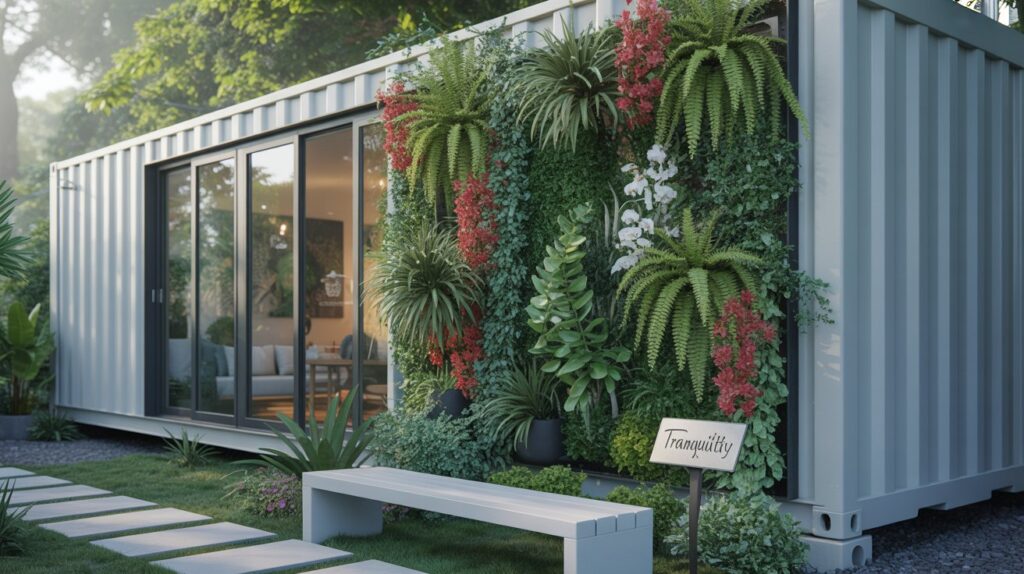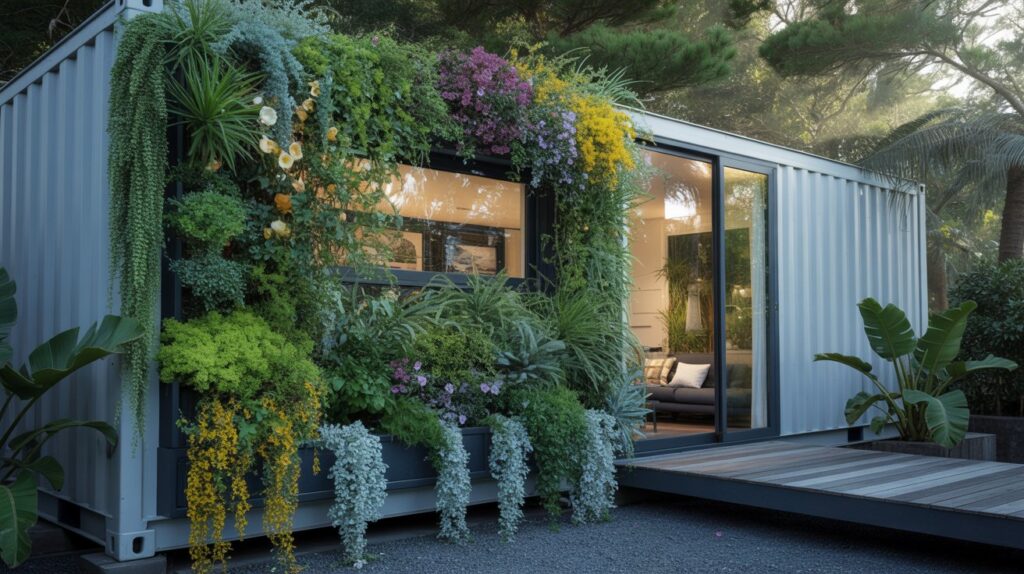Have you ever considered how to bring a touch of nature into your shipping container home? With limited space, traditional gardening may seem impossible, but vertical gardening offers an innovative solution. It’s a wonderful way to maximize space while enhancing the aesthetics and air quality of your unique dwelling. This method allows you to grow a variety of plants, providing beauty and function without demanding extensive ground area.
Understanding Vertical Gardens
Vertical gardens, sometimes known as living walls or green walls, enable you to grow plants up vertically along walls or other structures. These gardens essentially transform underutilized vertical spaces into vibrant, thriving plant habitats. The concept is simple enough: use plans and structures to allow plants to grow upward instead of out. This can be as simple as a DIY project or as intricate as professionally designed systems.
Benefits of Vertical Gardening
While vertical gardens serve an aesthetic purpose, they offer a wide range of benefits beyond beauty. First, they greatly save space, allowing you to grow an impressive number of plants without needing extensive ground areas. This makes them ideal for compact spaces like shipping container homes. Furthermore, vertical gardens can improve air quality, as the plants filter pollutants and release oxygen, making your home a healthier, more pleasant place to live.
Besides, these gardens can significantly enhance insulation for your shipping container home. The extra layer of plants and soil aids in regulating temperature, thus potentially reducing energy costs. Furthermore, creating a vertical garden can also increase biodiversity, providing essential habitats for beneficial insects and birds.
Choosing Your Vertical Garden Design
Given the spatial constraints of a shipping container home, the design you choose for your vertical garden is crucial. You’ll need to consider a balance between function and form, ensuring that the garden is both effective in terms of space-saving and appealing to the eye.
Simple DIY Vertical Garden Ideas
If you’re a DIY enthusiast, there are several simple vertical garden ideas you can try. For instance, using wooden pallets is a popular option due to their availability and ease of use. You can affix pots or small planters to the slats, creating an organized and rustic appearance. Alternatively, hanging planters or pocket planters can be attached directly to the walls. These are often made from felt or canvas and are great for small plants and herbs.
Example: Wooden Pallet Design
To create a wooden pallet garden, you’ll need:
| Materials | Tools |
|---|---|
| Wooden pallets | Hammer |
| Geotextile fabric | Nails |
| Potting soil | Staple gun |
| A variety of plants | Scissors |
- Prepare the pallet: Sand it to remove any rough edges.
- Line with fabric: Use geotextile fabric to line the back and bottom to hold soil and moisture.
- Fill with soil: Add potting soil to each row.
- Plant your choices: Plant according to your preference, ensuring each plant has enough space to grow.
This setup is both economical and eco-friendly, offering a sustainable way to personalize your living space.
Professional Systems
There are also professional, ready-made vertical garden systems available for those who may not have the time or inclination for DIY projects. These systems vary in complexity and price, but most are designed to be user-friendly and efficient. Some of the most common types include hydroponic systems, which use a water-based nutrient solution and soil-free medium, and modular systems, which are pre-fabricated panels that can easily be affixed to walls.

Selecting Plants for Your Vertical Garden
Choosing the right plants for your vertical garden is another crucial step towards a flourishing setup. You’ll want to select plants that are well-suited to vertical growth and compatible with the climate and light conditions of your location.
Types of Plants
- Succulents: These are ideal for vertical gardens due to their low maintenance nature and ability to thrive in small substrates.
- Herbs: Basil, mint, and parsley are not only easy to grow vertically but also offer culinary benefits.
- Flowers: Petunias and nasturtiums add color and attract beneficial insects.
- Ferns and Foliage Plants: Plants such as Boston ferns and philodendrons thrive in shady areas and contribute lush greenery.
Light and Water Requirements
It’s essential to consider the light and water needs of your chosen plants. Group plants with similar requirements together to ensure they thrive. Most vertical gardens require regular watering, especially if they are outdoors or exposed to direct sunlight. Automated irrigation systems can be particularly helpful in maintaining consistent moisture levels.
Care and Maintenance
Just like any garden, vertical setups need regular care and maintenance to flourish. One of the most significant aspects of maintenance is ensuring that your plants receive adequate water.
Watering
The watering technique will significantly depend on your chosen system. For example, soil-based vertical gardens in wooden pallets will typically need manual watering, while hydroponic systems might have self-watering capabilities. If you opt for a more traditional setup, consider using a drip irrigation system to help keep things easier.
Pruning and Replacing
Regular pruning is essential to keep your plants healthy and to encourage growth. Remove any dead or decaying leaves and blooms to prevent disease and pests. Occasionally, you may need to replace plants that have outgrown their spaces or are not thriving.
Pest Control
Vertical gardens are generally less prone to pests compared to traditional gardens, but it’s still essential to keep an eye on potential issues. Introducing beneficial insects like ladybugs can help control pests naturally. Alternatively, you can create homemade insecticidal soap using water and dish soap to treat minor infestations.

Creative Design Ideas for Vertical Gardens
A vertical garden is not just about functionality; it is also an opportunity to express creativity. Consider whimsical patterns or color-themed plant arrangements to enhance your shipping container home’s aesthetics.
Integrating Vertical Gardens Indoors
Indoor vertical gardens can create a stunning focal point in any room. Consider using shelves or multiple tiers of hanging planters to add depth and dimension to your space. A kitchen vertical garden stocked with fresh herbs serves both an aesthetic and practical purpose, offering fresh ingredients at your fingertips.
Outdoor Vertical Gardens
For outdoor spaces, consider using trellises or lattice structures covered with climbing plants like jasmine or morning glories. This setup can serve as a beautiful and aromatic privacy screen. Creative use of recycled materials, such as old gutters or pipes, can add an industrial charm that complements the shipping container aesthetic.
Costs and Considerations
Setting up a vertical garden in your shipping container home can vary in cost depending on the design complexity, materials, and plants you choose. A DIY project using recycled materials can be cost-effective, while a professionally installed system will be more expensive.
Budget-Friendly Options
- Upcycled Materials: Using recycled materials such as pallets or old containers helps reduce costs.
- Seedlings vs. Mature Plants: Opt for seedlings, which are generally less expensive than mature plants.
- DIY Structures: Build your frames and supports to save on the cost of prefabricated systems.
Professional Installation
Professional installations offer convenience and reliability but come at a higher price. These services often provide customized solutions, ensuring optimal plant health and a beautiful design tailored to your home’s specifications.
Conclusion
Creating a vertical garden for your shipping container home is a remarkable way to enhance the space with lush, vibrant plants, using what might otherwise be overlooked surfaces. Whether you choose a simple DIY setup or decide to invest in a professional system, incorporating a vertical garden not only beautifies your home but also provides environmental and health benefits. From succulent walls to herb gardens, your vertical garden can be as diverse and unique as you desire. Ultimately, it’s all about finding what suits your space, style, and gardening skills, transforming your living space into a green sanctuary.

